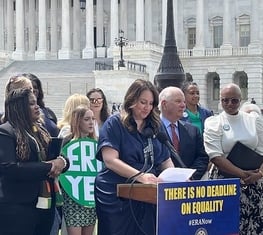LWV of Ohio Files Lawsuit to Correct Flawed Signature Match Process for Absentee Ballots
COLUMBUS—Today, the League of Women Voters of Ohio and the A. Philip Randolph Institute filed a lawsuit, along with an individual Ohio voter, challenging Ohio’s flawed system of matching voter signatures on absentee ballots and absentee ballot applications.
“Ohio’s confusing, inconsistent signature match process too often results in eligible Ohio voters incorrectly having their absentee applications or ballots rejected,” said Jen Miller, Executive Director of the League of Women Voters of Ohio. “Without clear notification or an efficient way to address questions about their signatures, too many voters are disenfranchised by this process, especially those with disabilities, senior citizens, young people, and naturalized citizens. Especially during a global pandemic, Ohio voters must be able to efficiently secure absentee ballots and have assurance that their votes will count.”
The League and partners are asking the court to declare the current signature-matching policies unconstitutional and issue an order to Secretary of State Frank LaRose to cease all signature matching of absentee ballot applications and ballots until a uniform and constitutional standard across county board of elections is implemented.
“More voters than ever are expected to cast ballots by mail this year, and yet problems like Ohio’s flawed signature match process threaten this important and just option,” said Dr. Deborah Turner, president of the board of directors of the League of Women Voters of the United States. “All voters must be able to cast their mail-in ballots safely and with confidence that their votes won’t be rejected for signature issues without remedy or recourse.”
The League of Women Voters is represented in this case by the American Civil Liberties Union, ACLU of Ohio, and the Lawyers' Committee for Civil Rights Under Law.
“Record numbers of Ohioans will vote by mail in the November 2020 election. But the patchwork of signature-matching processes across our state is incredibly subjective and fraught with error. On top of this, voters don’t get adequate notice or opportunity to fix their supposed mismatches. This will disenfranchise tremendous numbers of people,” said Freda Levenson, legal director of the ACLU of Ohio.
Election officials—who have no handwriting-analysis expertise—are currently allowed to reject an absentee ballot or ballot application, sometimes without notifying the voter, if they think there is a signature mismatch on the voter’s paperwork.
“Ohio’s extremely flawed signature-match process disenfranchised voters in the primary and will disenfranchise voters in the general election. All voter suppression tactics—no matter the shape or size—disproportionately affect voters of color, and we cannot allow this to happen. The right to vote is sacred and should be treated as such,” said Andre Washington, president of the Ohio A. Philip Randolph Institute.
Counties also differ as to the standards they use to analyze signature matching, the procedures they follow to reject perceived mismatches, the notice they provide to voters whose applications are rejected, the opportunity they give to cure absentee ballot applications that have been rejected on the basis of signature mismatch, and the record-keeping they do to document this activity.
The lawsuit, League of Women Voters of Ohio v. Frank LaRose, was filed in U.S. District Court for the Southern District of Ohio.
###
CONTACT: Kayla Vix | 202-809-9668 | [email protected]
The Latest from the League
The League of Women Voters of Ohio filed an amicus brief in the case Ex Rel. Ohio Democratic Party v. Frank LaRose. The case concerns when and how to conduct Ohio’s rescheduled primary election in light of last week’s postponement due to COVID-19.
A federal judge ruled that North Dakota’s process for absentee ballot verification will include a notification and remedy method for voters whose ballots are flagged for rejection due to signature mismatch.
Parties in LWV New Jersey v. Way drafted reached an agreement establishing a notice and cure process for vote-by-mail ballots in New Jersey.
Sign Up For Email
Keep up with the League. Receive emails to your inbox!
Donate to support our work
to empower voters and defend democracy.





